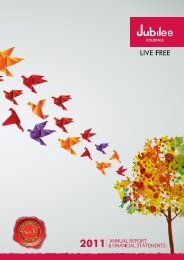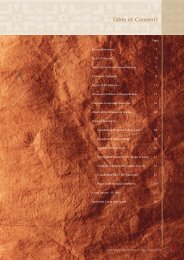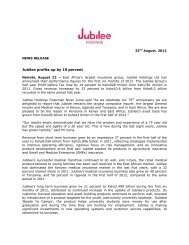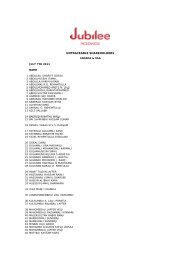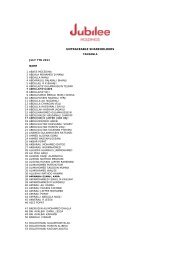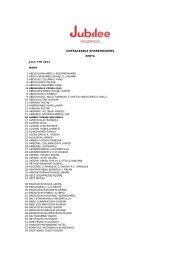Jubilee Insurance 2010 Annual Report
Jubilee Insurance 2010 Annual Report
Jubilee Insurance 2010 Annual Report
Create successful ePaper yourself
Turn your PDF publications into a flip-book with our unique Google optimized e-Paper software.
28<br />
JUBILEE HOLDINGS<br />
ANNUAL REPORT AND FINANCIAL STATEMENTS<br />
FOR THE YEAR ENDED 31 ST DECEMBER <strong>2010</strong><br />
NOTES (continued)<br />
2. Summary of significant Accounting Policies (continued)<br />
2.13 CASH AND CASH EQUIVALENTS<br />
Cash and cash equivalents includes cash in hand, deposits held at<br />
call with banks, other short term highly liquid investments with original<br />
maturities of three months or less, and bank overdrafts.<br />
2.17 DIVIDENDS<br />
Dividends payable to the Group’s shareholders are charged to equity in<br />
the period in which they are declared. Proposed dividends are shown as<br />
a separate component of equity until declared.<br />
2.18 SHARE CAPITAL<br />
2.14 EMPLOYEE BENEFITS<br />
(i) Retirement benefit obligations<br />
The Group operates defined contribution retirement benefit scheme<br />
for its employees. A defined contribution plan is a pension plan<br />
under which the Group pays fixed contributions into a separate entity.<br />
The Group has no legal or constructive obligations to pay further<br />
contributions if the fund does not hold sufficient assets to pay all<br />
employees the benefits relating to employee service in the current and<br />
prior periods.<br />
The assets of all schemes are held in separate trustee administered<br />
funds, which are funded by contributions from both the Group and<br />
employees. The Group and all its employees also contribute to the<br />
appropriate National Social Security Fund, which are defined<br />
contribution schemes. The Group’s contributions to the defined<br />
contribution schemes are charged to the income statement in the year<br />
to which they relate.<br />
(ii) Other entitlements<br />
The estimated monetary liability for employees’ accrued annual leave<br />
entitlement at the reporting date is recognised as an expense accrual.<br />
2.15 INOME TAX EXPENSE<br />
Income tax expense is the aggregate of the charge to the income statement<br />
in respect of current income tax and deferred income tax.<br />
Current income tax is the amount of income tax payable on the taxable<br />
profit for the year determined in accordance with the relevant tax<br />
legislation.<br />
Deferred income tax is provided in full, using the liability method, on<br />
all temporary differences arising between the tax bases of assets and<br />
liabilities and their carrying values for financial reporting purposes.<br />
However, if the deferred income tax arises from the initial recognition of<br />
an asset or liability in a transaction other than a business combination<br />
that at the time of the transaction affects neither accounting nor taxable<br />
profit nor loss, it is not accounted for. Deferred income tax is determined<br />
using tax rates and laws that have been enacted or substantively enacted<br />
at the balance sheet date and are expected to apply when the related<br />
deferred income tax liability is settled. Deferred income tax assets are<br />
recognised only to the extent that it is probable that future taxable profits<br />
will be available against which the temporary differences can be utilised.<br />
Deferred income tax is provided on temporary differences arising on<br />
investments in subsidiaries and associates, except where the timing of the<br />
reversal of the temporary difference is controlled by the Group and it is<br />
probable that the temporary difference will not reverse in the foreseeable<br />
future.<br />
2.16 BORROWINGS<br />
Borrowings are recognised initially at fair value, net of transaction costs<br />
incurred. Borrowings are subsequently stated at amortised cost using<br />
the effective interest method; any differences between proceeds (net of<br />
transaction costs) and the redemption value is recognised in the income<br />
statement over the period of the borrowings.<br />
Borrowings are classified as liabilities unless the Group has an<br />
unconditional right to defer settlement of the liability for at least 12 months<br />
after the reporting date.<br />
Shares are classified as equity when there is no obligation to transfer<br />
cash or other assets. Incremental costs directly attributable to the issue<br />
of equity instruments are shown in equity as a deduction from the<br />
proceeds, net of tax.<br />
2.19 CONCESSION ARRANGEMENTS<br />
One the Group entities have entered into an arrangement to construct<br />
a public utility on behalf of a government under ‘build-operate-transfer<br />
service concession arrangement. This arrangement is accounted for in<br />
accordance with IFRIC 12 – “Concession Arrangement”. In order to fall<br />
within the scope of IFRIC 12 a contract must satisfy two criteria:<br />
The grantor controls or regulates what services the operator must provide<br />
with the infrastructure, to whom it must provide them and at what price;<br />
and<br />
The grantor controls significant residual interest in the infrastructure at the<br />
end of the concession arrangement.<br />
In accordance with IFRIC 12, such infrastructure are not recognised as<br />
assets of the operator as property, plant and equipment but either as<br />
financial assets (using the financial asset model) or intangible assets<br />
(using the intangible assets model). The infrastructure with respect of the<br />
construction is accounted for as a financial asset as in this case the Group<br />
has an unconditional right to receive cash from government while not<br />
retaining any significant demand risk.<br />
Financial assets resulting from the application of IFRIC 12 are recorded as<br />
non-current assets and measured at amortised cost.<br />
In accordance with IAS 39 – Financial Instruments, an impairment loss is<br />
recognised if the carrying amount of these financial assets exceeds their<br />
fair value, which is computed by estimating the recoverable amount using<br />
discounted cash flows.<br />
3. CRITICAL ACCOUNTING ESTIMATES AND JUDGEMENTS IN APPLYING<br />
ACCOUNTING POLICIES<br />
The Group makes estimates and assumptions that affect the reported<br />
amounts of assets and liabilities within the next financial year. Estimates<br />
and judgments are continually evaluated and based on historical<br />
experience and other factors, including expectations of future events<br />
that are believed to be reasonable under the circumstances. The critical<br />
accounting estimates and assumptions applied in the year are:<br />
a) Fair value estimation<br />
The fair value of financial instruments that are not traded in an active<br />
market is determined by using valuation techniques. These include the<br />
use of valuation technique such as price earnings ratios basis.<br />
b) <strong>Insurance</strong> contracts<br />
The estimation of future benefit payments from long-term insurance<br />
contracts is the Group’s most critical accounting estimate. There are<br />
several sources of uncertainty that need to be considered in the estimate<br />
of the liability that the Group will ultimately pay for such claims.<br />
Management applies judgement in the estimation of incurred but not<br />
yet reported claims (IBNR) whereby the Group uses historical experience<br />
to estimate the ultimate cost of claims and the IBNR provision. This<br />
involves the analysis of historical claims development factors and the<br />
selection of estimated development factors based on this historical<br />
pattern. The selected development factors are then applied to claims<br />
data for each accident year that is not fully developed to produce<br />
an estimated ultimate claims cost for each accident year. Note 28<br />
contains further details on the estimation of insurance liabilities.<br />
JUBILEE HOLDINGS



